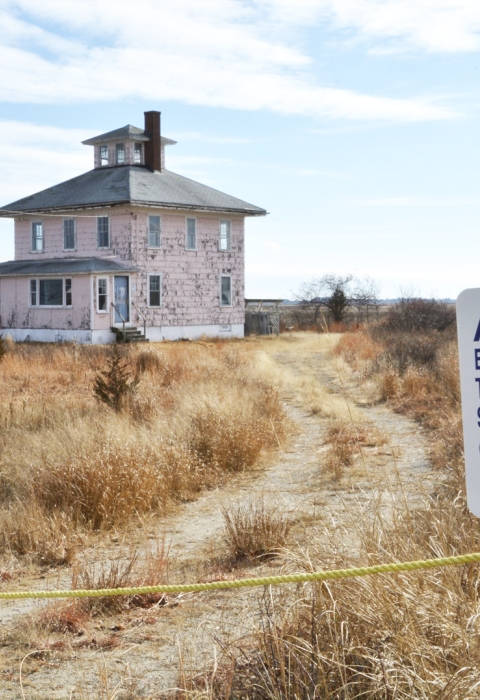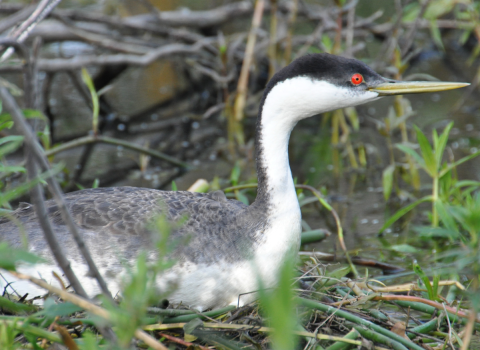Following a 30-day public comment period on a draft Environmental Assessment (EA), the U.S. Fish and Wildlife Service has released a “Finding of No Significant Impact” for its proposal to remove the Pink House at Parker River National Wildlife Refuge. The Service will remove the uninhabited structure structure
Something temporarily or permanently constructed, built, or placed; and constructed of natural or manufactured parts including, but not limited to, a building, shed, cabin, porch, bridge, walkway, stair steps, sign, landing, platform, dock, rack, fence, telecommunication device, antennae, fish cleaning table, satellite dish/mount, or well head.
Learn more about structure at 60 Plum Island Turnpike, Newbury, MA, restore the habitat for wildlife and open a portion of the property to the public. In response to community feedback, the Service made notable improvements to its plan:
- The Service will list the house at public auction for relocation or salvage. If successful, the community could continue drawing inspiration from it at another site or in another form
- Instead of an observation platform, the Service will install only benches and educational panels for public use at the restored site. A low-profile platform may be constructed in the future, based on public interest and wildlife and habitat monitoring
- To save the house from removal, staff have worked with partners since 2016 to locate a suitable property with which to exchange the land where the house sits. Despite an exhaustive search — including extensive outreach and media coverage since release of the draft EA nearly five months ago, and an additional 2-month extension — no viable exchange parcels were located
To maintain the house in perpetuity would strain the refuge's limited resources at the expense of wildlife conservation and other visitor needs. It contains materials harmful to human health, including asbestos, and requires frequent maintenance to prevent catastrophic damage. The property floods routinely — already twice this year — and sea level rise projections indicate flooding frequency in this area will increase. As a result, the long-term viability of the structure in its current location is untenable.
“I want to thank our community partners who worked so hard as we exhausted every option to find a solution to this complex issue,” said Refuge Manager Matt Hillman. “While we regret not reaching an outcome that satisfies all, we’re confident the decision aligns with our mission to protect and restore high-quality wildlife habitat and provide meaningful educational opportunities.”
Per the National Environmental Policy Act, the Finding of No Significant Impact and Environmental Assessment, including a response to public comments, can be downloaded from the refuge’s website or viewed at the visitor center (6 Plum Island Turnpike, Newbury, MA).
Frequently Asked Questions
Did you make any changes based on public comments?
Yes, we thoroughly reviewed every comment and made the following substantive changes to the final document:
Many comments, both for and against the proposal, advocated for memorializing the house, whether by relocation or repurposing its components. To further explore these possibilities, we are working with the General Services Administration to make the house available for off-site removal only.
- We will work with the community to commemorate the house via a history plaque or similar on-site display once it is removed.
- Many comments that opposed removing the house also opposed a public observation platform on the restored site; an opinion shared by several who supported the house’s removal, too. Others expressed concerns related to parking or public safety once the site is opened to the public. Recognizing these concerns, we will defer our decision to construct a platform based on site use monitoring data and public interest.
- We provided for a 2-month extension before finalizing the plan so additional land exchange properties could be thoroughly vetted.
- Figure 2 was added to show examples of the property flooding.
- Estimated costs to abate contaminants, remove the structure, fill the foundation, and restore the habitat were increased from $24,000 in the draft to $50,000-$90,000 in the final.
A draft version of the document depicting the substantive changes highlighted in yellow is available for review at the refuge’s Headquarters and Visitor’s Center.
How many public comments did you receive?
We received 396 public comments during the 30-day comment period. Of these, 78% advocated for preserving the house, while 21% stated that it should be removed. Appendix B of the Environmental Assessment contains a thorough analysis of all public comments and our responses.
What are the next steps required to implement the plan?
The US Fish and Wildlife Service (Service) will work with the General Services Administration to list the house for public auction, with a target of later this spring or early summer for a one-to-two-month auction. If the auction proceeds and is successful, the house would be relocated or repurposed this year, and if not successful, the Service will abate lead and asbestos hazards and remove the house.
What will happen to the property after the Pink House is removed?
Removal of the Pink House would create an opportunity to enhance both the future resiliency and public access opportunities in this area. This would include providing a small parking area on the existing driveway footprint and installing park benches and educational panels. An area that had long been closed to public access would afford a unique opportunity for people of all abilities to experience and learn about the Great Marsh ecosystem.
What is the Pink House?
Constructed in 1925, the Pink House is a 3-bedroom, two story former private residence situated along Plum Island Turnpike in Newbury, MA. It is surrounded by the turnpike to the north and salt marsh salt marsh
Salt marshes are found in tidal areas near the coast, where freshwater mixes with saltwater.
Learn more about salt marsh and tidal creek in all other directions.
Why and when did the Service acquire the Pink House?
The Service purchased the Pink House — along with more than nine acres of upland, salt marsh and tidal creek habitat — in 2011 to permanently protect the property and its sensitive habitats from development and to evaluate whether the house could be used for seasonal staff housing.
Why did the Service decide to remove the Pink House?
In 2014, a preliminary environmental survey of the building found that it contains over 3,000 square feet of asbestos, a serious human health risk. The house, in a state of disrepair when purchased, has continued to deteriorate. Given these health and safety hazards, the Service determined that the building is not suitable for staff housing, nor is there any other feasible use for the house.
Further, the property has become an attractive nuisance, requiring frequent law enforcement patrols and repairs due to vandalism. Maintenance staff time and funds are increasingly required to maintain structural stability and safety. The house has a permanently flooded basement, is within an active flood zone, and flooding has become more severe in recent months and years. Removing the house is therefore in the best interest of public safety, taxpayer money, and the environmental health of the area.
What has the Service done to save the house from removal?
In response to community members, the Service has worked diligently with landowners, elected officials, and local advocacy groups for eight years to find an equal-value land exchange. While several promising leads were pursued, none were ultimately successful, including scenarios outlined below. Additional land exchange opportunities will no longer be considered as the Service implements the final EA.
In the interest of safety, and to ensure the house remained intact to affect a land exchange, staff maintained the house to prevent catastrophic damage. The Service will continue to maintain the structure as required through the public auction process.
Could the Service sell or donate the Pink House property, including the land?
The Service has limited authority to sell or donate the land it administers under the National Wildlife Refuge System Administration of 1966, as amended (16 U.S.C. 668dd et seq.). Because the surrounding habitat is of high ecological value and supports the refuge’s mission, only an equal-value (i.e., $450,000+) land exchange applies to the land. The structure itself, however, could be excessed and removed, as described above.
Could the Pink House be repurposed for use by the Service or the public?
Due to the refuge’s core mission to protect wildlife and their habitats, and persistent flooding concerns of the property, the Pink House is not suitable for use by Service employees or members of the public in its present location. However, through the General Services Administration auction process, the house may be relocated or removed and repurposed by interested buyers.
Could the Pink House be restored by volunteers or private contractors at their own expense?
Health and safety hazards prevent the Service from accepting volunteer restoration work due to risk of serious injury. Further, federal law stipulates that contracted construction work undergo a competitive bidding process and adhere to federal wage and labor standards.
Is the Pink House listed on the National Register of Historic Places?
No, in 2010 and again in 2021, the Massachusetts Historical Commission determined that the house does not meet the criteria for listing on the National Register of Historic Places and is therefore ineligible. For more information, see Appendix A of the Final EA.





